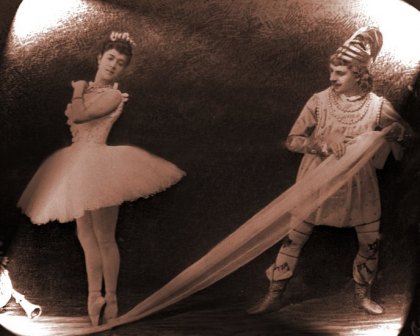The Nutcracker's holiday spell broken

Two cast members from the 1892 production in Russia.
A recent critique in The Week magazine ("The Creep of The Nutcracker") points to sexual overtones between a principal character, the mysterious Herr Drosselmeyer, and the ballet's young protagonist, Clara.
The context: Set at a Christmas Eve party, Clara (also called Marie or Masha in various versions), fights with her brother, Fritz, over a nutcracker given to her by Drosselmeyer, an eye-patch wearing friend of the family. After the party, the girl falls asleep and dreams that the nutcracker is a prince.
While vapid, the ballet has remained insanely popular for decades. Anyone enrolled in a ballet school for any length of time has been in The Nutcracker. Small towns have at least one performance; cities have multiple productions. The ballet would have sellout crowds if it were staged at a landfill.
Next Christmas, Disney will release a star-studded film version, The Nutcracker and the Four Realms, featuring a performance by Misty Copeland, principal dancer at the American Ballet Theatre. Already, the trailer (below) has gone viral. That means next year's holiday season promises wall-to-wall nutcrackers on stages and cinema screens everywhere -- just as the story is getting a second, uncomfortable look.
The problem is Drosselmeyer, the story's magical helper, who arrives for Christmas Eve celebrations carrying elaborate presents -- in the ballet, life-sized dancing dolls. After the party, the revelers leave and Clara goes to bed. But later, she awakens and tiptoes into the parlor. Alone, she spots Drosselmeyer, who appears on top of a clock. He flaps his arms like an owl, writes George Balanchine and Francis Mason in the book, 101 Stories of the Great Ballets (Doubleday; 1975). The girl is thoroughly terrified.
At once beloved and creepy, Herr Drosselmeyer is ultimately confusing.
"For Clara as for The Nutcracker's young audiences, the journey to the Land of Sweets and back offers a magical glimpse of adulthood even as it raises suspicions about that vision. How much of it is Clara's?" asks Blaine Greteman, a professor at University of Iowa and a journalist, in The Week. "How much does Drosselmeyer produce by manipulating his machines or shaping Clara's imagination of herself? Drosselmeyer should disturb us not because he is aberrant, but because he enacts in sugar-plum form the strategies that men have long used to manage and control female sexuality."
This is the sort of thing that once you see, you cannot un-see. And if the criticism sticks, it could prompt dance companies and perhaps patrons to rethink their interest in the ballet. But in reality, it is also true that most productions miss the point of the original story, a coming-of-age fairy tale.
The ballet is based on The Nutcracker and the Mouse King by E.T.A. Hoffmann (1776-1822). After Hoffmann’s death, Alexandre Dumas (1802-1870) rewrote and softened the story. This version was used by Lev Ivanov while choreographing the ballet, which premiered in St. Petersburg, Russia, 125 years ago this week, Dec. 17, 1892. Peter Ilyich Tchaikovsky wrote the famous score.
In 101 Stories of the Great Ballets, Balanchine (1904-1983) recounts portraying various roles during his boyhood in Russia. Decades later, American ballet companies began producing the the ballet. But Balanchine, who had come to the U.S. in 1933, proved central to The Nutcracker's place as a Christmas tradition. As ballet master of the New York City Ballet, he staged his choreography of The Nutcracker in 1954. A decade later, the company moved to a larger stage, the scenery was redesigned, and an over-the-top tradition was born.
In his book, Balanchine wrote that he based his version on the Hoffmann story. But Hoffmann’s tale is darker.
Early on, Drosselmeyer shows the children an elaborate model he has built -- a castle, with clear glass windows and golden turrets. When the children are unimpressed, his mean streak surfaces. “An ingenious work like this was not made for stupid children,” he snaps.
He also gives the family a nutcracker, and in the book, the girl notices similarities between the toy and Drosselmeyer. She becomes convinced that the nutcracker is Drosselmeyer’s spellbound nephew.
Her mother tells her she has been dreaming and "now drive it all out of your head." In a fit of tough love, her father threatens to toss the nutcracker and all her dolls out the window.
This sequence is at the heart of the story, for Hoffmann worked to balance his obligations and his artistic bent. Educated in law, he made his living as a legal official in Berlin.
“The struggle within Hoffmann between the ideal world of his art and his daily life as a bureaucrat is evident in many of his stories, in which characters are possessed by their art,” explains an article on the Encyclopedia Britannica website.
It is no accident that Clara prefers the nutcracker's fantastical world to her parents' reality. As the story ends, Drosselmeyer’s nephew comes to visit, and he looks much like a nutcracker brought to life. It is the nephew -- not Drosselmeyer -- who marries the girl. She grows to womanhood, but unlike others, refuses to leave her dreams behind.
At this hour, Hoffmann concludes, the girl is "queen of a land where sparkling Christmas woods and transparent marzipan castles, in short, where the most beautiful, the most wonderful things, can be seen by those who will only have eyes for them."
Related:
'The Night Before Christmas' author on trial
Follow StudyHall.Rocks on Twitter or like us on Facebook and tell us what you think.

